|
Physics |

|
EOS |
|
Rocket Science |

|
Data for individual stages. |
|
*derived from T/R **Derived from m0fuel/tfinal ***First of two separate burns; second burn 312 seconds. Total fuel for third stage = 0.103x106 kg with total burn time of 477 seconds giving a net fuel burn rate of 216 kg/s |
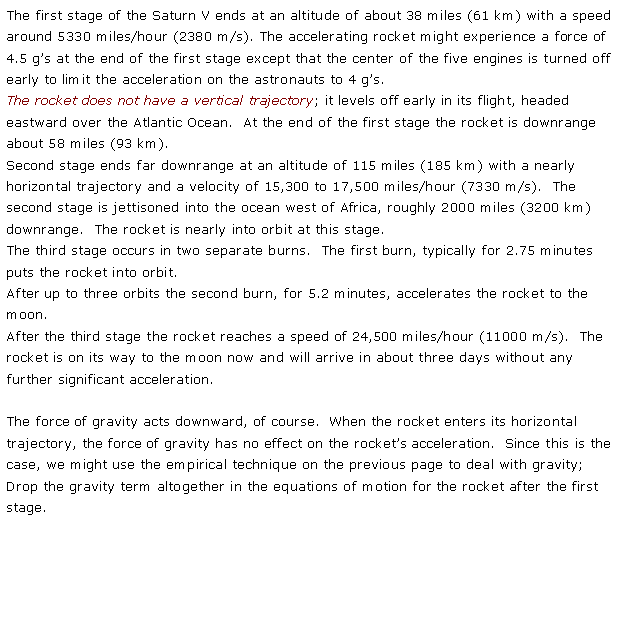
|
Stage 1 Saturn V. Although it was launched from the Earth’s surface, gravity is neglected in these calculations. |
|
//////////////////////////////////////////////////////////////\\\\\\\\\\\\\\\\\\\\\\\\\\\\\\\\\\\\\\\\\\\\\\\\\\\\\\\\\\\\\
|
|
Stage 1— On the launch pad fully laden with fuel and payload.
m0fuel = 2.04x106 kg initial amount of fuel mbody = 2.77x106 kg (everything on launch pad) - m0fuel = 0.73x106 kg minitial = 2.77x106 kg = mbody +m0fuel vexhaust = 2456 m/s mass of the frame to jettison = 0.136x106 kg since all fuel is consumed, mfinal = mbody R = 13600 kg/s tfinal = 150 seconds = the duration of the burn
|
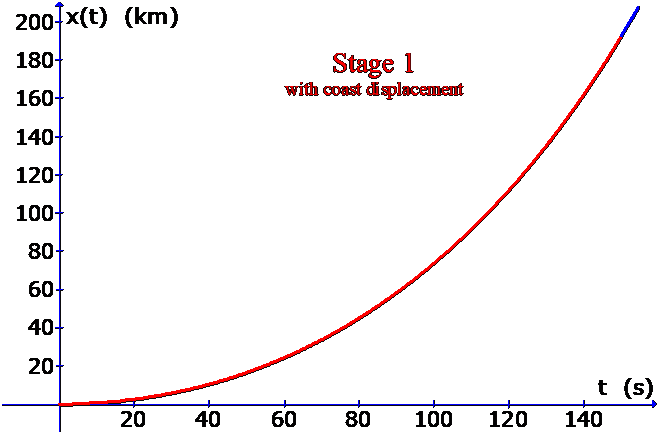
|
*linear displacement **4.4 second coast period between first and second stages; displacement given by xcoast = tcoast vfinal |
|
Stage 1 Notes vfinal = 3275 m/s = 7300 miles per hour a(t=0) = 12.1 m/s2 = 1.2 g’s a(tfinal) = 4.7 g’s on track here; NASA says the rocket could generate 4.5 g’s at the end of Stage 1 x(tfinal) = 120 miles |
|
Stage 1 Results and Graphs — no gravity |
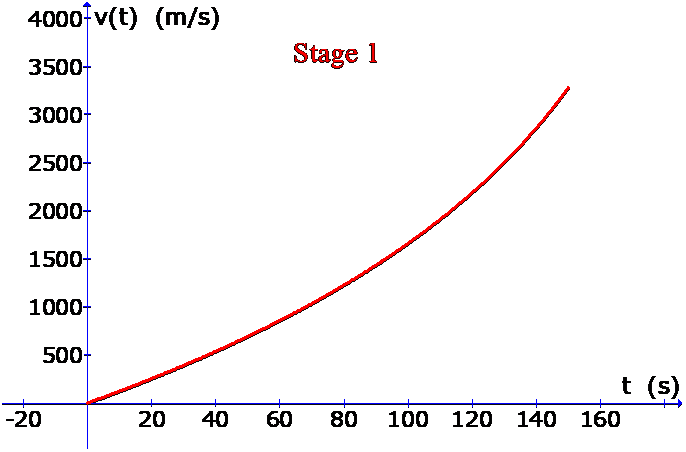
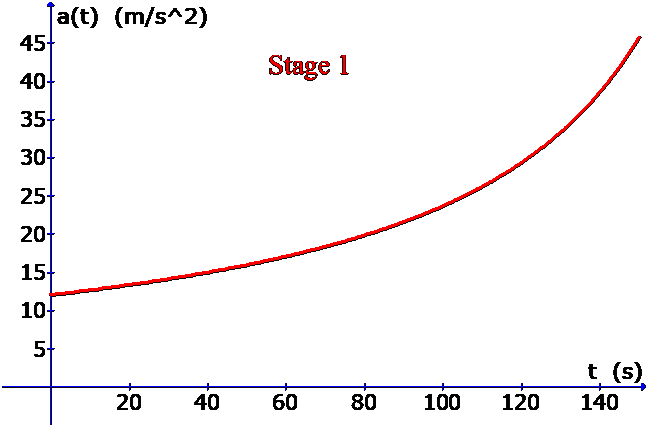
|
The results of this calculation give a first stage final distance of 120 miles with a speed of 7300 miles/hour, whereas NASA says that the first stage of the Saturn V ends at an altitude of 38 miles with a speed of 5330 miles/hour. Without gravity the rocket would be travelling at more than seven thousand miles per hour — after only the first stage! — and after only two and one-half minutes! I would like to know what the speed after the third stage would be. |

|
Stage 1 Saturn V. Taking into account the component of gravity along the direction of motion using the empirical method given on page 4. Tau = 256 seconds is selected to match the velocity curve to NASA velocity data at end of Stage 1. |
|
*linear displacement **4.4 second coast period between first and second stages; displacement given by xcoast = tcoast vfinal |
|
Stage 1 Notes vfinal = 2384 m/s = 5330 miles per hour; tau selected to match NASA data. Acceleration at lift-off: a(t=0) = 2.3 m/s2 = .23 g’s a(tfinal) = 3.1 g’s x(tfinal) = 78 miles; reasonable; this would include the 38 mile altitude and some distance downrange. |


|
Stage 1 Results and Graphs including gravity term g’ = g cos[(pi/2) t /tau)] tau = 256 seconds g’ = 5.94 m/s2 |
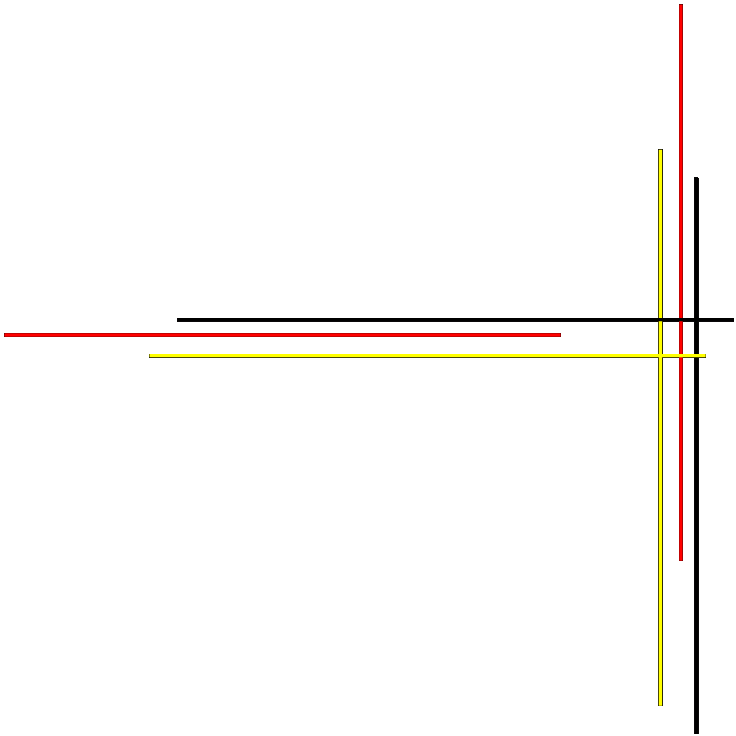

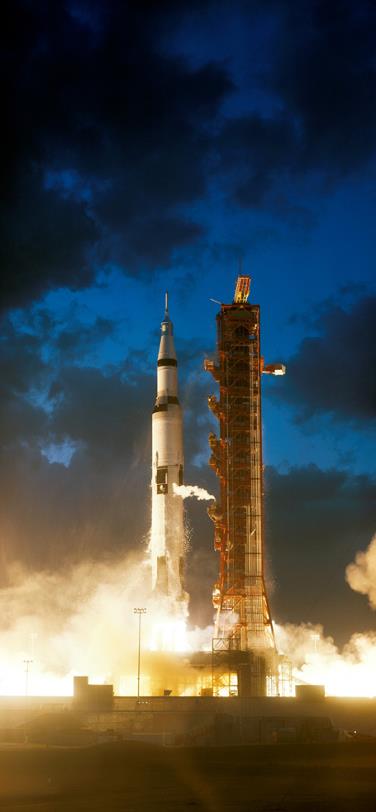
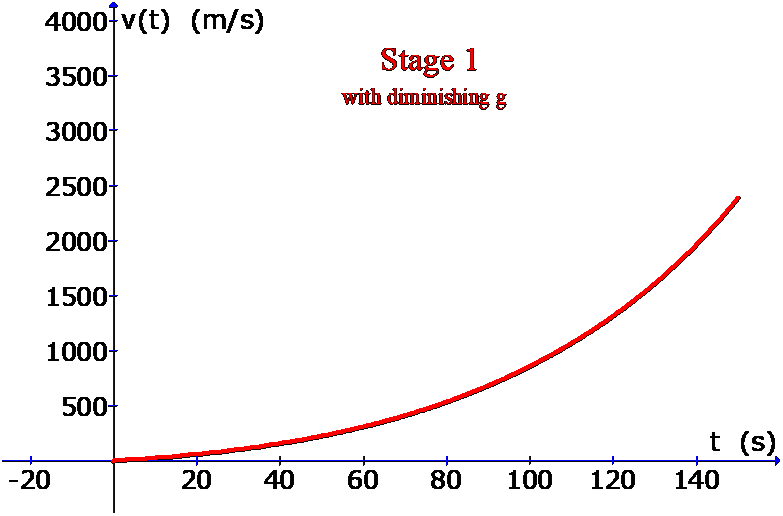
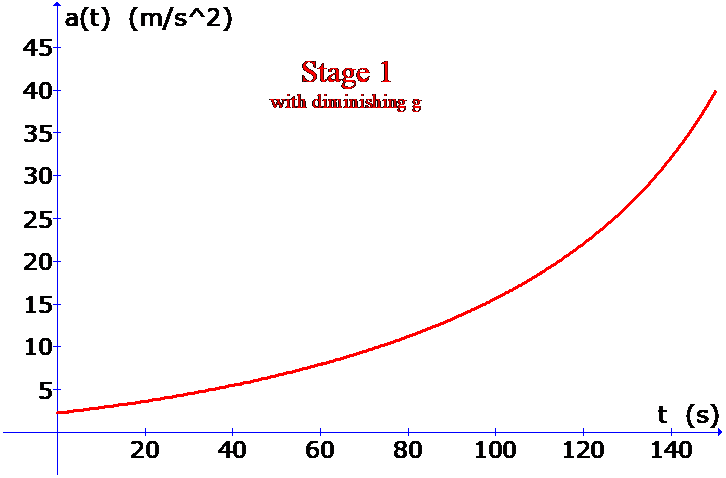
|
This latest result gives the Stage 1 displacement as 78 miles (x(tfinal) = 126 km); this is the distance traveled by the rocket. As the NASA data mentions, at the end of the first stage the rocket is downrange about 58 miles (93 km) with an altitude of 38 miles. The graph below shows a hypothetical trajectory based on natural log, a*ln(b*x+1), with a steep ascent and which has a path length of 78 miles, showing that it is not impossible to fit this result within NASA’s data. Using the velocity data to estimate the diminishing g, and now matching the path length, I think this has worked reasonably well. |
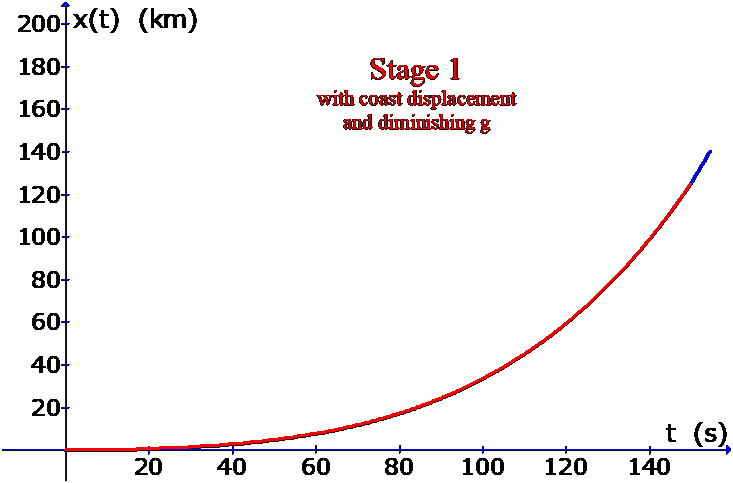
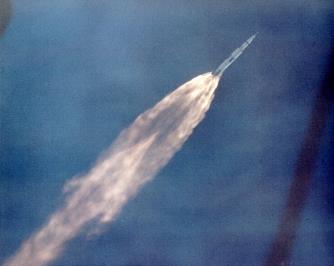
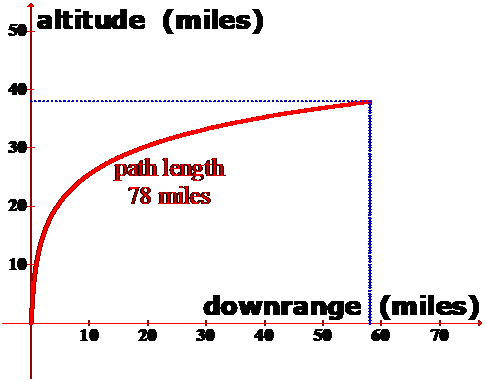
|
Page 1 Momentum Derivation of the Rocket Equation Thrust
Page 2 Speed of the Rocket During the Burn
Page 3 Rocket Acceleration Position as a Function of Time
Page 4 Gravity
Page 5 Saturn V Data Stage 1 Calculation
Page 6 Saturn V Stage 2, Stage 3 Calculations
Page 7 Saturn V Photo Gallery
Page 8 Saturn V Photo Gallery
Page 9 Equation Review |
|
5 Saturn V—Stage 1 |
|
H The Saturn V Rocket
The Saturn V was a powerful rocket ultimately used to launch the Apollo spacecraft toward the moon. It was a three stage rocket which had a total mass of 2.77x106 kg at lift-off.
First stage The first stage produced 33.4x 106 N (7.5 million pounds ) of thrust with five engines. The duration of the burn is 150 seconds . The fuel was 768,000 liters (203,000 gallons ) of refined kerosene, and the oxidizer was 1,250,000 liters (331,000 gallons ) of liquid oxygen (LOX). This amounts to 0.614x 106 kg of kerosene and 1.43x 106 kg of LOX, for a total fuel mass of 2.04x 106 kg . The mass of the frame of the first stage was 0.136x 106 kg . This is jettisoned after the fuel is expended. 4.4 second coast period between first and second stages
Second Stage Five engines produced a thrust of 4.46x106 N . The burn duration was 361 seconds . The fuel was 984,000 liters (260,000 gallons ) of liquid hydrogen; the oxidizer was 314,000 liters (83,000 gallons ) of LOX. The total mass of fuel for this stage was [0.0699x106 kg (LH)+ 0.358x106 kg (LOX)] = 0.428x106 kg . The frame of the second stage had a mass of 0.0432x106 kg . This too is jettisoned after its fuel is expended. 6.5 second coast period between second and third stages
Third stage Single engine stage produced 1.00x106 N of thrust. Burn time for the entire load of fuel was 477 seconds. This rocket engine would burn for 165 seconds (2.75 minutes ) not expending all of the fuel. This puts the rocket into orbit around the earth, "Earth Parking Orbit" (EPO) for up to three revolutions while system checkout is performed. Then, if all systems are "go" the remaining fuel would burn for 312 seconds (5.2 minutes ) putting the rocket into its trajectory towards the moon ("translunar injection"). Total mass of the fuel for this stage was 0.0119x106 kg . Empty, the frame of the third stage had a mass of 0.0154x106 kg . In addition to the frame there was a .00204x106 kg (45,000 pound ) instrument package, which sat atop the third stage, used to control the three stages in flight: ignition and cutoff of the engines, steering, and any other controls for the Saturn V rocket. This total mass was 0.0174x106 kg .
Above the third stage was the Apollo spacecraft. |
|
Stage 1 equations
|
|
Stage 1 equations with g
|
|
|
m0fuel Fuel Mass (x106kg) |
T Thrust (x106N) |
tfinal Burn Duration (s) |
vexhaust* Exhaust Velocity (m/s) |
R** Burn Rate (kg/s) |
Frame Mass to jettison (X106kg) |
|
First stage |
2.04 |
33.4 |
150 |
2456 |
13600 |
0.136 |
|
Second stage |
.428 |
5.02 |
360 |
4220 |
1190. |
0.0432 |
|
Third stage a |
0.0356 |
1.00 |
165*** |
4630 |
216. |
— not yet |
|
b |
0.0674 |
1.00 |
312 |
4630 |
216. |
0.0174 |
|
minitial (x106kg) |
mfinal (x106kg) |
vinitial (m/s) |
vfinal (m/s) |
a(t=0) (m/s2) |
a(tfinal) (m/s2) |
x(tfinal)* (km) |
xcoast** (km) |
Final displacement (km) |
|
2.77 |
.73 |
0 |
3275 |
12.1 |
45.8 |
192.6 |
14.4 |
207 |
|
|
|
|
|
|
|
|
|
|
|
minitial (x106 kg) |
mfinal (x106 kg) |
vinitial (m/s) |
vfinal (m/s) |
a(t=0) (m/s2) |
a(tfinal) (m/s2) |
x(tfinal)* (km) |
Xcoast ** (km) |
Final Displacement (km) |
|
2.77 |
.73 |
0 |
2384 |
2.3 |
30. |
126 |
10.5 |
136 |
|
|
|
|
|
|
|
|
|
|